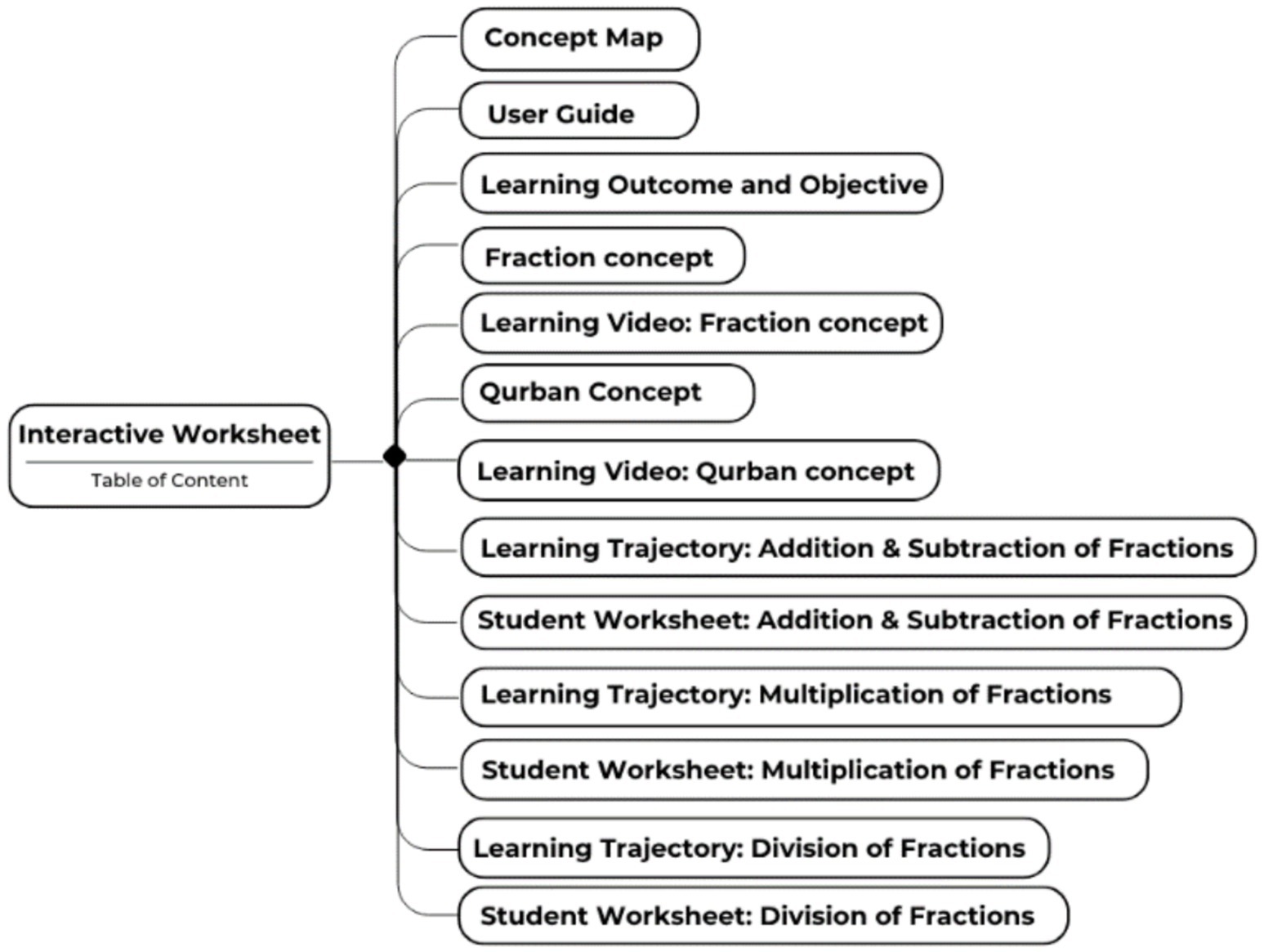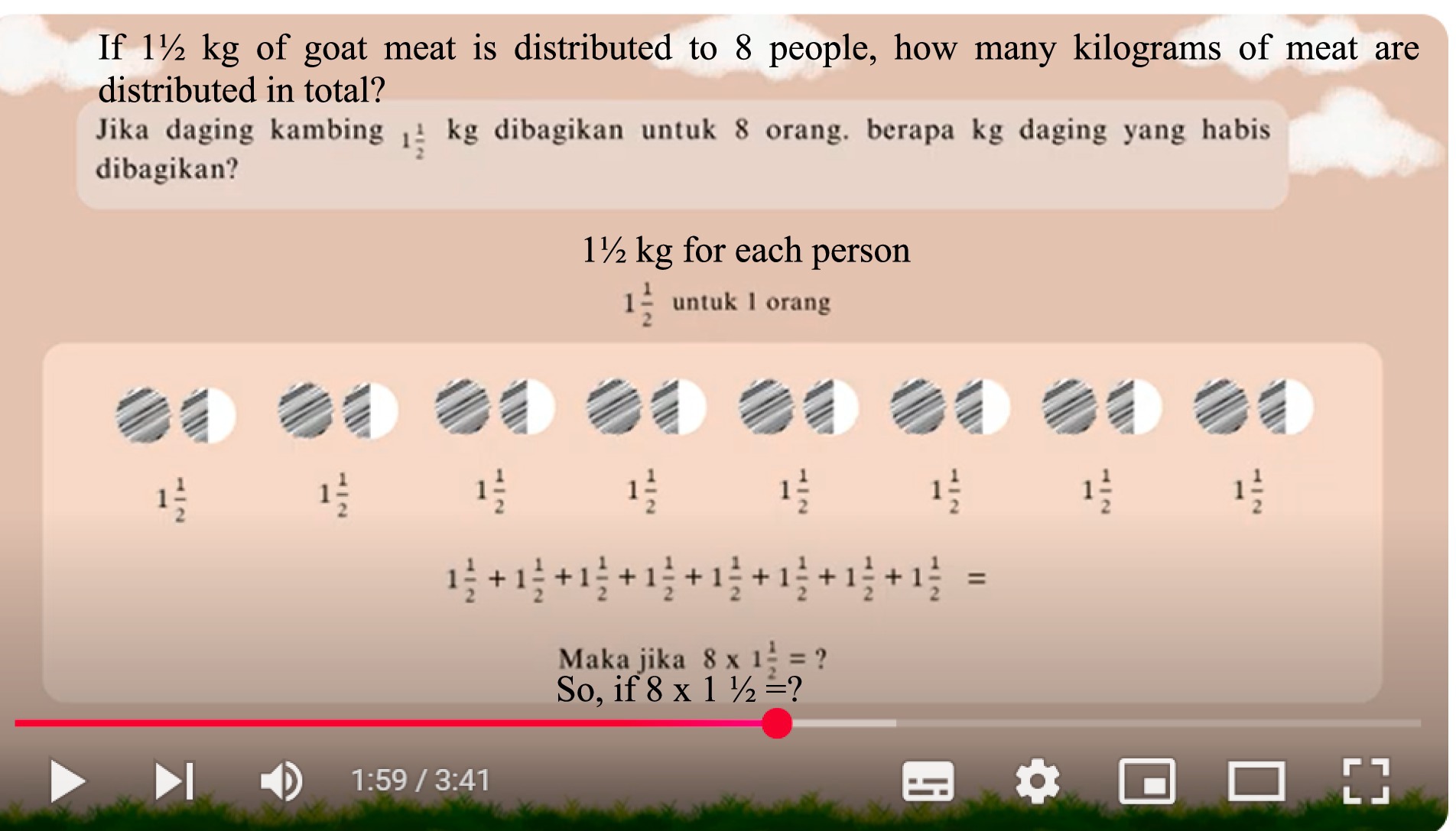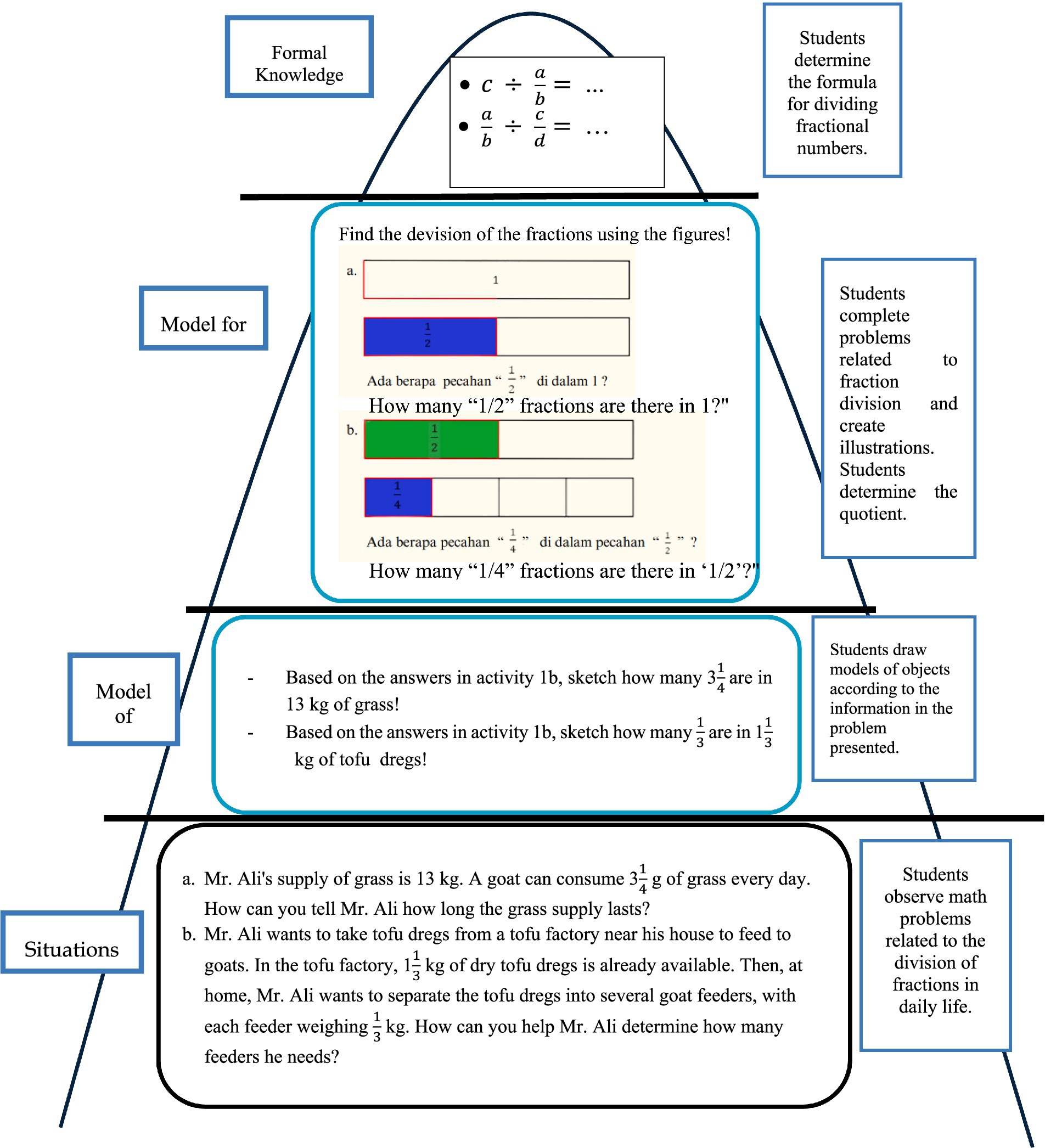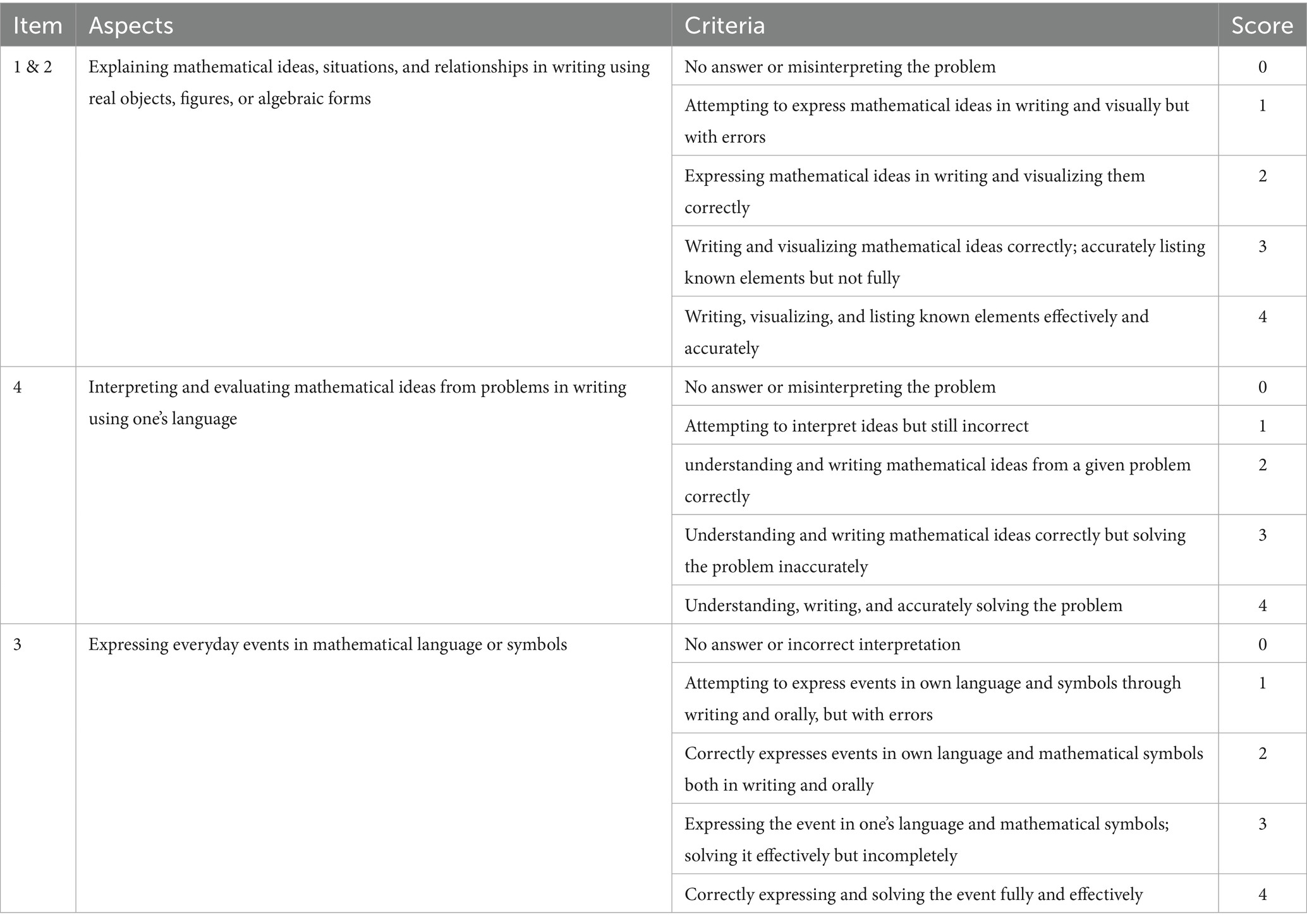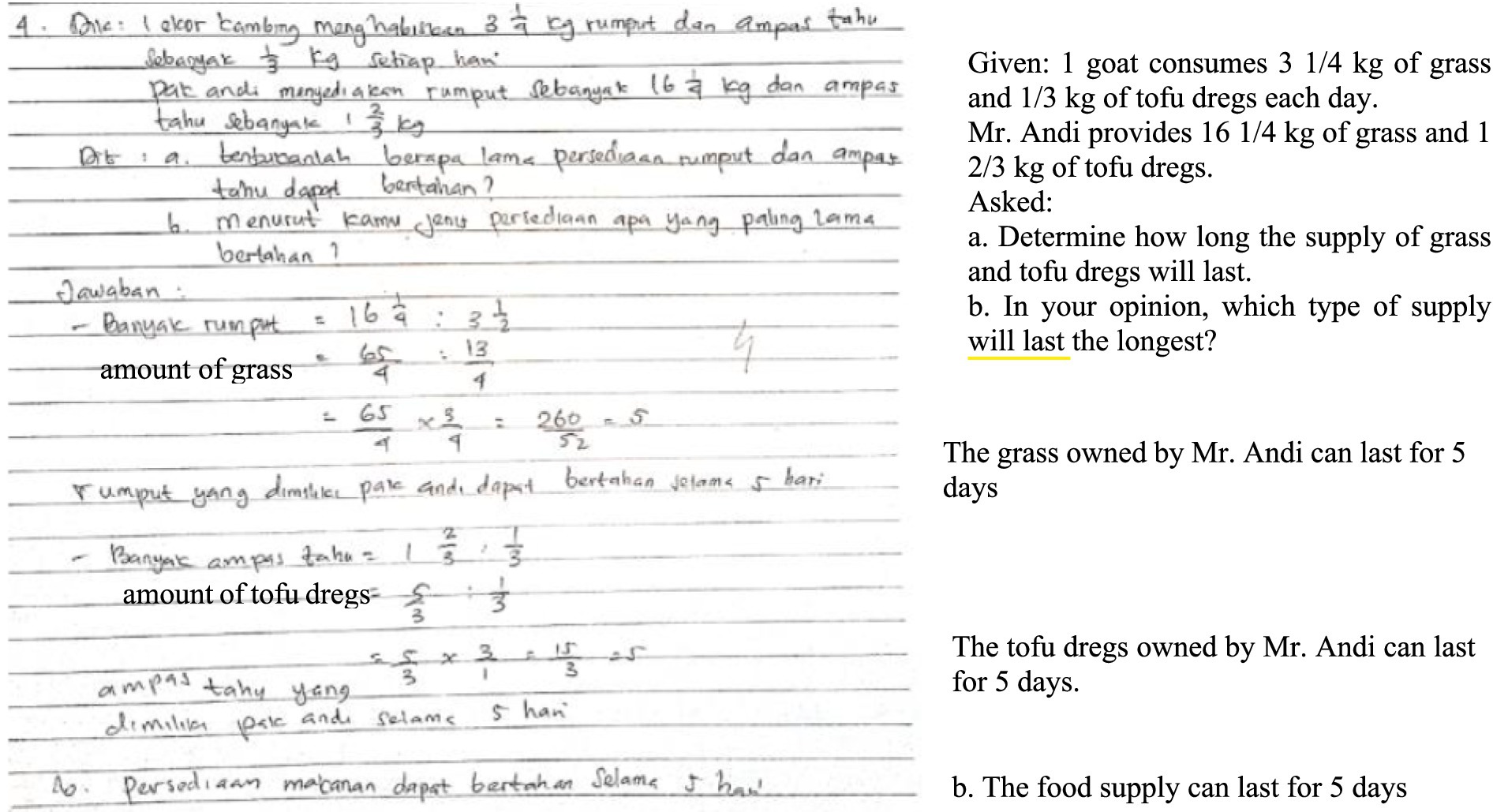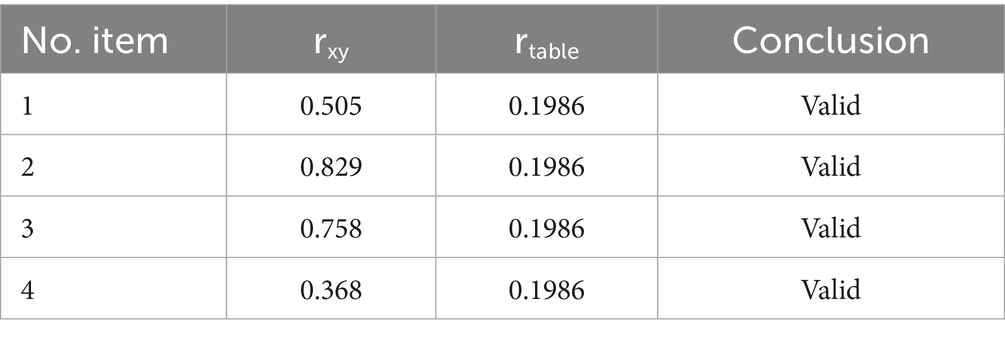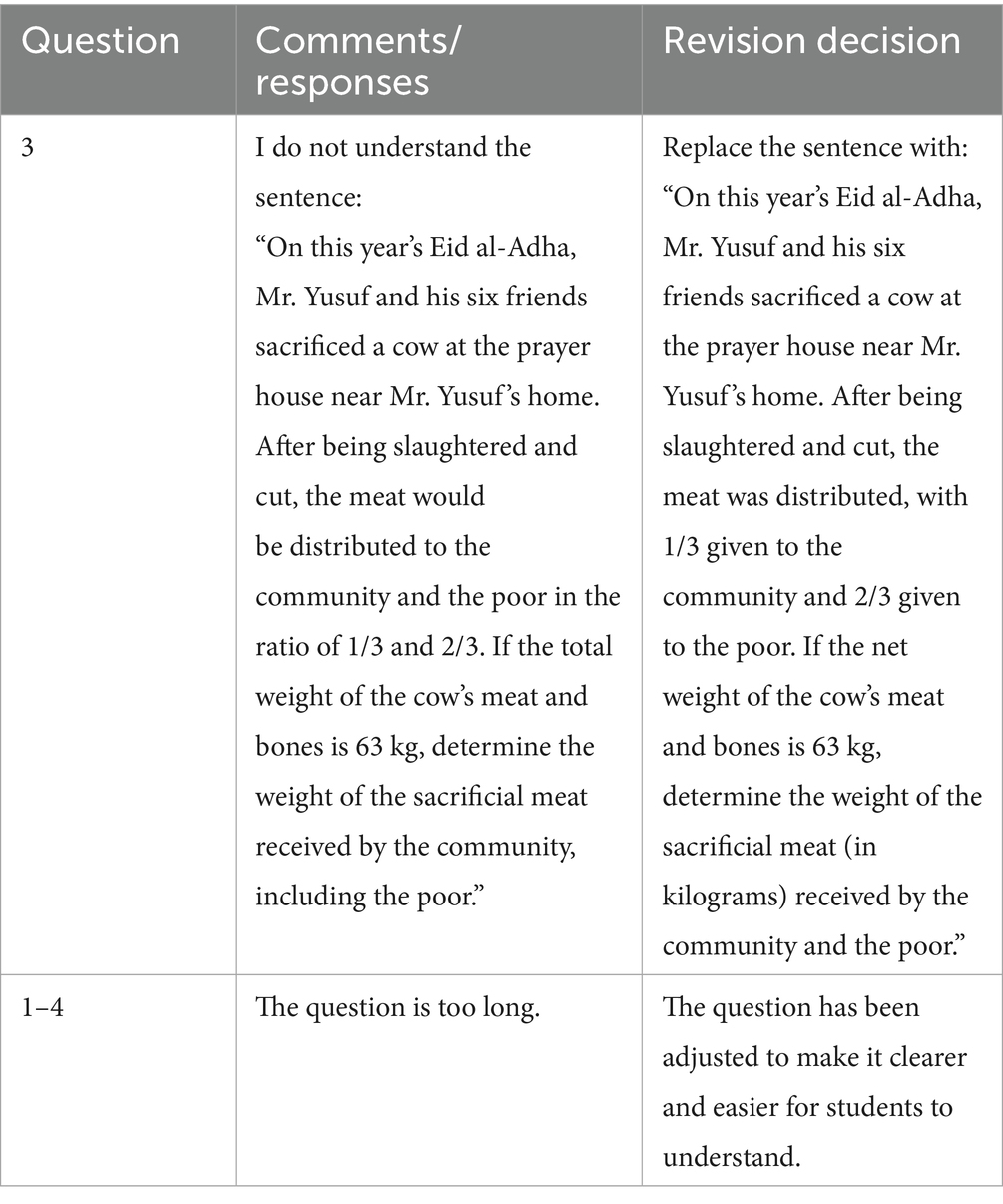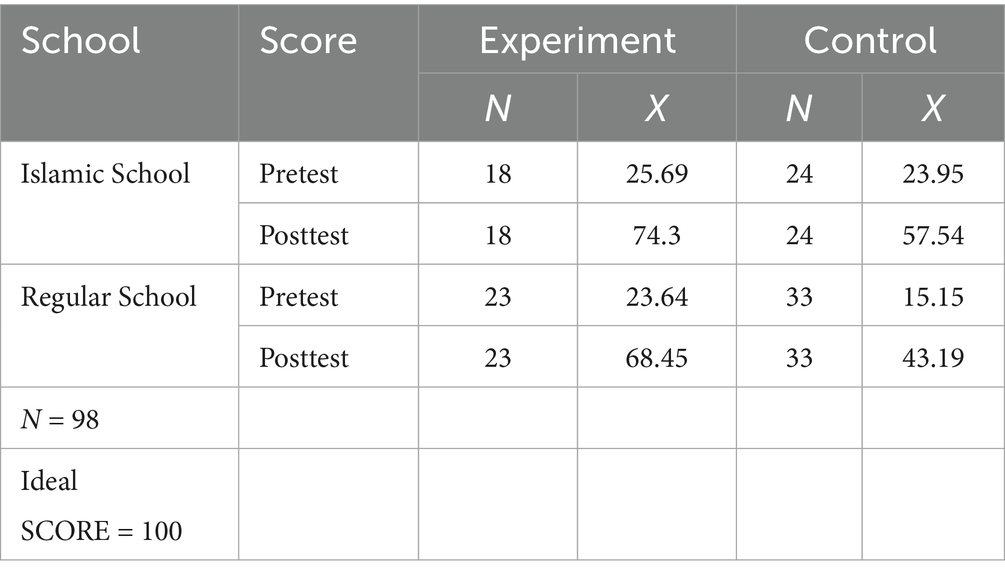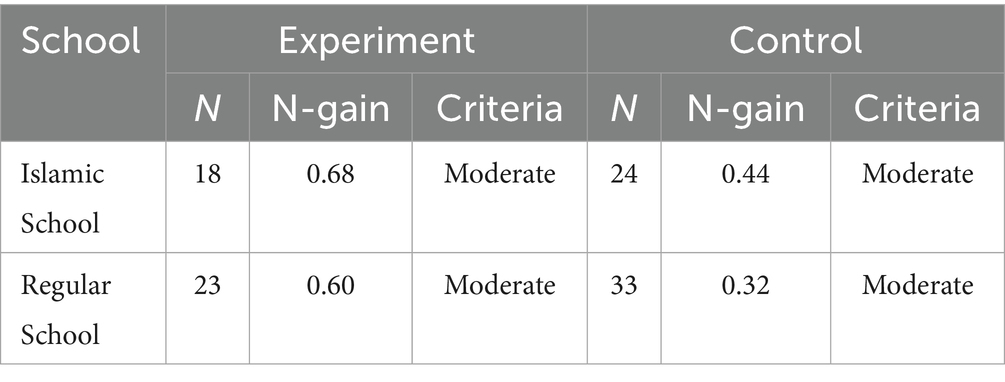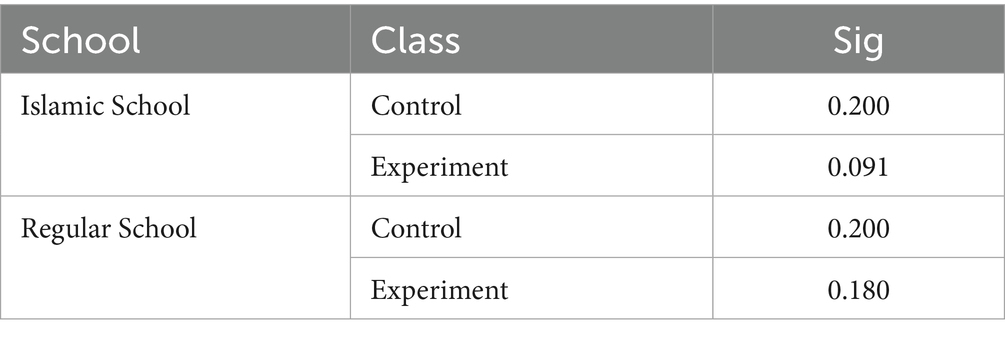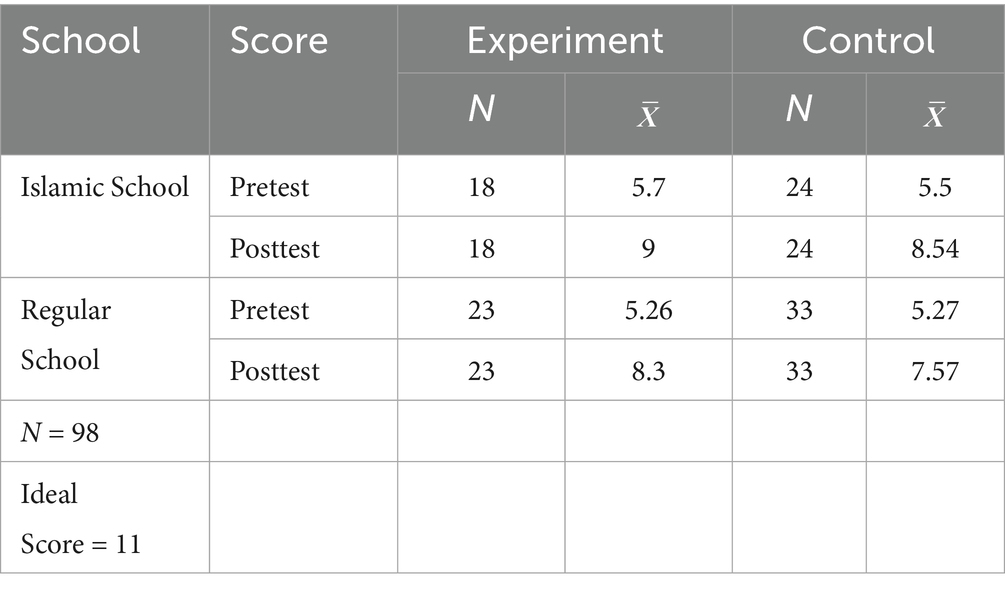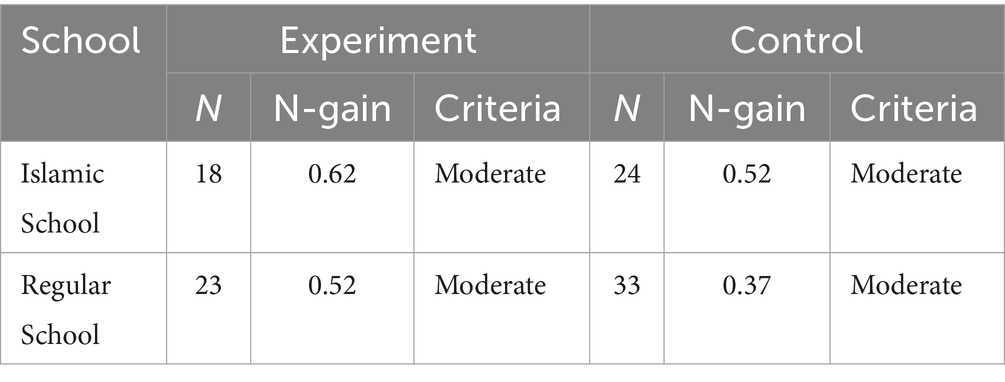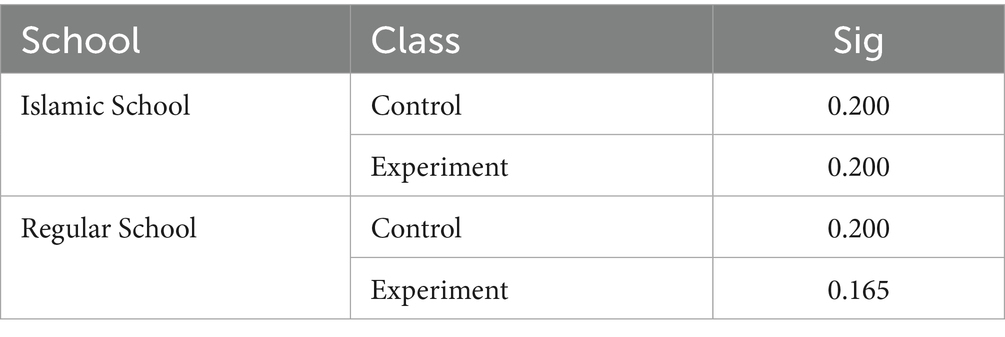- 1Department of Mathematics Education, Universitas Syiah Kuala, Banda Aceh, Indonesia
- 2The Research Center of Realistic Mathematics Education, Universitas Syiah Kuala, Banda Aceh, Indonesia
- 3Faculty of Law, Universitas Syiah Kuala, Banda Aceh, Indonesia
- 4School of Education and Human Sciences, AlBukhary International University, Alor Setar, Malaysia
Mathematical communication skills are essential for helping students grasp mathematical concepts. Fostering students’ knowledge of Islamic values can also encourage them to relate mathematical topics to real-world situations, particularly in worship, enhancing their mathematical communication. Therefore, an innovative teaching approach is crucial to improving students’ mathematical communication and understanding of Islamic values. This study investigates the integration of these concepts within mathematics through the contextualized framework of Qurban. The study explores how an interactive worksheet can enhance mathematical communication skills and knowledge of Islamic values among junior high school students in Islamic and regular schools. Using a quantitative approach with a pretest-posttest control group design, the study involved 98 seventh-grade students from Banda Aceh, Indonesia, drawn from both school types. Two classes (experimental and control) from each school were randomly selected as samples. Data was collected using a mathematical communication test and a questionnaire on students’ knowledge of Islamic values. The data was analyzed using a t-test and MANOVA. This study revealed five key findings. First, a significant difference was found in the improvement of mathematical communication skills between students taught using interactive worksheets and those taught without them in the Islamic school. Second, a similar difference was observed in the regular school, where students taught using interactive worksheets demonstrated greater improvement in mathematical communication skills compared to those who were not. Third, no significant difference was identified in the improvement of knowledge of Islamic values between students taught with and without interactive worksheets in the Islamic school. Fourth, in contrast, a significant difference was found in the regular school, with students using interactive worksheets showing greater improvement in knowledge of Islamic values. Fifth, the type of school had no significant effect on the improvement of students’ mathematical communication skills or their knowledge of Islamic values. However, the use of interactive worksheets was found to have a significant effect on the improvement of both mathematical communication skills and knowledge of Islamic values. Thus, this study suggests that the effectiveness of interactive worksheets on students’ knowledge of Islamic values varies across different school contexts.
1 Introduction
Mathematical communication is a critical standard that must be cultivated in mathematics education. This standard emphasizes the need for students to articulate their mathematical thinking with peers and teachers consistently. It also requires students to use precise mathematical language to convey mathematical ideas (Baroody, 2000; NCTM, 2000; Rubenstein and Thompson, 2002; Whitin and Whitin, 2003). Mathematical communication skills include expressing, understanding, interpreting, assessing, and responding to mathematical ideas and effectively using terms, notations, and symbols to present these ideas (Rohid, 2019). When students communicate their thoughts to others, it can enhance their conceptual understanding, improve problem-solving skills, and correct misconceptions about mathematical concepts (Lee, 2015; Astuti and Leonard, 2015). Smieskova (2017) argued that mathematical communication skills foster students’ creativity and motivation. One area of mathematics where these skills are particularly essential is fractions. Fractions are a fundamental concept with significant applications in everyday life and are crucial for success in mathematics. Learning about fractions broadens students’ understanding of whole numbers to rational numbers (Siegler and Lortie-Forgues, 2014). It forms the foundation for decimals, percentages, ratios, and the symbolic calculation of rational numbers (Ni and Zhou, 2005). From Grades 6 to 8, students are expected to work flexibly with fractions, decimals, and percentages to solve mathematical problems (Zhang et al., 2016). The recently released Common Core State Standards (CCSS, 2012) in mathematics also highlight the importance of fraction proficiency as a foundational component of pre-algebra readiness. Students’ proficiency in fractions has been shown to predict overall math achievement (Bailey et al., 2012), underscoring the importance of mastering this topic. However, students often encounter substantial challenges in understanding fractions. Research indicates that students experience difficulties with fraction concepts at various grade levels (Isik and Kar, 2012; Unlu and Ertekin, 2012; Stafylidou and Vosniadou, 2004). Seventh-grade students experience difficulties in understanding the concept of fractions (Shalonda, 2024).
Students are not yet able to interpret 2:1/2 as how many 1/2 in 2 (Bergeson, 2000; Newstead and Murray, 1998). Additionally, students often misinterpret that 1/4 is greater than 1/3 and 1/2 + 1/3 = 2/5 (Ni and Zhou, 2005). Guiler (1945) also found that 42.5% of students demonstrated weaknesses in performing addition operations with fractions and mixed numbers. Furthermore, the proportion of students who experienced difficulties with subtraction, multiplication, and division of fractions and mixed numbers was nearly twice as high as those struggling with addition. This is because students’ ability to solve mathematical problems in various contexts is still low (OECD, 2023).
At the same time, mathematics learning today is also increasingly framed within the paradigm of STEM Education. Bybee (2013) views STEM education as a paradigm that is inherently interdisciplinary, with a focus on real-world problem solving. In this framework, the effectiveness of technology can enrich STEM education by presenting abstract concepts in a more tangible way and fostering deeper understanding through experiential learning (Tene et al., 2024). Thus, the integration of RME and STEM perspectives can provide a more holistic approach to teaching fractions, linking real-life contexts with cross-disciplinary learning opportunities.
One approach to mathematics learning that begins with a real context is Realistic Mathematics Education (RME). Real problems, namely real or reasonable problems (common sense), are close to students or can be imagined in students’ minds (van den Heuvel-Panhuizen, 2005; van den Heuvel-Panhuizen and Drijvers, 2020). Treffers (1987) suggested that in learning with RME, students are involved in horizontal mathematization which is the transformation of real problems into mathematical problems and vertical mathematization is related to processing in mathematics itself.
Fraction-related problems are commonly encountered daily, including within the context of Qurban, an integral part of Muslim worship. However, students often have a limited understanding of Islamic teachings, and there is generally a lack of interest in Islamic education in schools (Rosila and Yaakob, 2007). The decline in moral and religious values underscores the need for educational reform (Rahman et al., 2015; Irawan and Kencanawaty, 2017). Abdussakir and Rosimanidar (2017) emphasized that Islam integrates both scientific and religious knowledge. Incorporating Islamic culture and values into mathematics instruction is also a goal in Aceh Province, as outlined in Qanun Aceh No. 5 of 2008, aiming to cultivate individuals with strong faith and knowledge in science and technology (Walidin, 2005). Religious values related to faith, sharia, and morality can be effectively reinforced through mathematics education (Salafudin, 2015; Ulpah and Novikasari, 2020). Ulpah and Novikasari (2020) revealed that integrating mathematics with an Islamic context can help students relate mathematical topics to real-world events and challenges, particularly in worship activities and can enhance students’ mathematical understanding. Meanwhile, this study integrates Islamic context, specifically related to Qurban, with the topic of fractions, aiming to improve students’ mathematical communication skills in both Islamic and regular schools in Banda Aceh.
Islamic schools in Banda Aceh are divided into two categories, namely Madrasah Schools and Integrated Islamic Schools. Madrasah schools have many religious subjects, such as Arabic, Al-Quran Hadith, Fiqh, Aqidah Akhlak, and the History of Islamic Civilization. However, subjects other than religion such as mathematics, science and social studies are not integrated with religion lessons. On the other hand, at the Integrated Islamic School, the subjects of Al-Quran Hadith, Fiqh, Aqidah Akhlak, and History of Islamic Civilization are combined into Religion subjects so that there are four types of subjects, namely Religion subjects, Arabic, Tahfidz, and subjects other than Religion. Subjects other than religion such as mathematics, science and social studies are integrated with religious studies. For example, classroom discussions often include moral reflections that connect the subject matter with verses from the Qur’an or Hadith of the Prophet, promoting both intellectual development and character formation. Integrated Islamic School implement the Integrated Islamic School Network Curriculum (JSIT), combining the national curriculum and integrated Islamic School curriculum (Ismail, 2018). Under the JSIT curriculum, all subjects are expected to incorporate Islamic values (Muhab, 2014). Haryaningrum et al. (2017) explained that this curriculum includes structured learning activities, self-development, habits, and distinctive school programs, all delivered through a full-day school system. In this research, the Islamic school used was the Integrated Islamic School. Regular School is one of the State Junior High Schools (SMPN) in Banda Aceh. At regular school, the subjects Al-Quran Hadith, Fiqh, Aqidah Akhlak, History of Islamic Civilization are combined into Religion subjects so that there are three types of subjects, namely Religion subjects, Arabic and subjects other than Religion. Subjects other than religion, such as mathematics, science and social studies, are integrated with religion lessons.
Previous research on the use of interactive worksheets, such as that by Dewi et al. (2022), found that digital worksheets with accessible interfaces and well-structured inquiry-based stages enhanced student independence and stimulated science process skills among elementary school students during pandemic learning. Hake (1997) suggested that interactive learning techniques stimulate classroom engagement and positively impact students’ long-term academic performance. Another study by Utaminingsih et al. (2024) found that the design of mathematics instruction using interactive digital worksheets has proven effective in enhancing students’ critical thinking skills. In addition, the implementation of these interactive digital worksheets is beneficial in managing various challenging learning activities and supports the realization of meaningful learning experiences for students. However, while existing research on interactive worksheets has explored various student outcomes, no studies have specifically addressed students’ mathematical communication skills and knowledge of Islamic values. Therefore, this study examined these aspects using interactive worksheets in Islamic and regular school settings.
1.1 Research objectives
RO1: This study aims to examine whether there is a difference in the improvement of mathematical communication skills between students taught using interactive worksheets and those taught without interactive worksheets in Islamic schools.
RO2: This study aims to examine whether there is a difference in the improvement of mathematical communication skills between students taught using interactive worksheets and those taught without interactive worksheets in regular schools.
RO3: This study aims to investigate whether there is a difference in the improvement of knowledge of Islamic values between students taught using interactive worksheets and those taught without interactive worksheets in Islamic schools.
RO4: This study aims to examine whether there is a difference in the improvement of knowledge of Islamic values between students taught using interactive worksheets and those taught without interactive worksheets in regular schools.
RO5: This study aims to determine whether school type and the use of interactive worksheets affect the improvement of students’ mathematical communication skills and knowledge of Islamic values.
2 Literature review
2.1 Technology integration in STEM education
Technology is not only increasingly adopted in educational settings but also has a significant impact on students’ engagement and performance. These findings affirm the effectiveness of fully integrated technology in enriching STEM education by making abstract concepts more tangible and fostering deeper understanding through experiential learning (Tene et al., 2024). Furthermore, technology in STEM should not be seen merely as a digital tool, but rather as an integral part of the broader STEM Education framework. This means that technology functions as a mediator that bridges students’ cognitive and affective learning. The use of mobile technology has shown a moderate and statistically significant positive effect on primary and secondary school students’ learning, both in cognitive, affective, and behavioral domains (Wang et al., 2022). In this sense, interactive worksheets, GeoGebra, and video prompts can be viewed as technological mediators that guide the enhancement of mathematical communication while also stimulating affective engagement and collaboration.
In this context, from the cognitive perspective, the use of technologies such as GeoGebra, instructional videos, and interactive worksheets has been proven to improve students’ critical thinking, mathematical communication, and conceptual understanding in solving fraction problems. Meanwhile, from the affective perspective, technology fosters emotional engagement, curiosity, as well as values of collaboration and social care through learning contexts relevant to real life, including authentic contexts such as zakat, qurban, Ramadan practices, disaster awareness, herbal medicine, low-carbon food, bees, and biodiversity. These contexts are presented in the form of e-modules and interactive mathematics worksheets available on the Getmath platform.1
By integrating various STEM disciplines, students can explore the interconnectedness across fields, develop holistic understanding, and equip themselves to face diverse real-world challenges (Sujarwanto et al., 2019). In this study, the theme of Qurban was used as an Islamic context developed in the form of interactive worksheets. The learning activities were designed through contextual problem solving, pattern matching, and visual exploration with GeoGebra, enriched with instructional videos and complemented with the iceberg approach. This approach not only strengthens students’ cognitive understanding of fraction operations but also fosters affective engagement through the internalization of Islamic values such as empathy, social care, and the spirit of sharing in the practice of qurban.
2.2 Enhancing mathematical communication through the use of interactive worksheets
Communication is a vital component of mathematics and mathematics education (NCTM, 2000). Therefore, teachers need to establish strong connections between mathematics and language (Rubenstein and Thompson, 2002; Stigler and Hiebert, 2004), as this connection allows students to express their mathematical ideas more clearly. Such interactions are especially beneficial for young learners, as they help clarify thinking and sharpen understanding as students attempt to make sense of the world through communication (Baroody, 2000; NCTM, 2000).
Furthermore, Pourdavood and Wachira (2015) emphasized that one of the key components influencing success in mathematics is attention to precision, which demands accuracy not only in computation but also in language use. This aligns with the findings of Manouchehri and St John (2006), who argued that communication in mathematics instruction contributes to deeper mathematical analysis for both teachers and students. Furthermore, the development of digital technologies has opened up new opportunities for students to construct and understand mathematical knowledge (Bray and Tangney, 2017), including the enhancement of mathematical communication skills. These skills can be facilitated through contextual, collaborative, and interactive learning strategies. In this study, mathematical communication is developed through the integration of videos and quizzes within interactive worksheets. The use of video prompts and visual simulations can increase students’ cognitive engagement and deepen their understanding of the subject matter.
H1: There is a significant difference in the improvement of mathematical communication skills between students taught using interactive worksheets and those taught without interactive worksheets in Islamic schools.
H2: There is a significant difference in the improvement of mathematical communication skills between students taught using interactive worksheets and those taught without interactive worksheets in regular schools.
2.3 Enhancing students’ knowledge of Islamic values through the use of interactive worksheets
Islamic values involve ethical reasoning, spiritual reflection, and moral practice. Research has shown the success of integrating Islamic ethics into the educational curriculum, with an emphasis on character development and the instillation of moral values across various fields of study (Ibrahim et al., 2024). These dimensions include honesty in problem-solving, justice in distribution, empathy and solidarity in social contexts, as well as spiritual awareness that mathematics is part of appreciating the order of God’s creation. In this context, the interactive worksheet is supplemented with Qur’anic verses, hadiths, and informational sections related to legal and humanitarian values. For example, “Then eat from them and feed the miserable and poor” (Qur’an, Al-Hajj: 28). This verse emphasizes the social value of empathy and solidarity toward the poor, while also teaching the ethical value of justice in distribution. It also contains a spiritual dimension, as it affirms that the qurban sacrifice is not merely a ritual, but a means of drawing closer to Allah SWT through sharing.
The integration of Islamic values in education is crucial in developing holistic character following the national and religious educational goals (Ferdinan and Pewangi, 2025). Mathematics in Islamic culture has broad scope and a high level of integration with religious teachings (Høyrup, 1987). Topics such as inheritance distribution, zakat, and arithmetic operations involving integers and fractions are closely related to Islamic religious education (Halistin et al., 2022). This connection provides opportunities for educators to develop learning Islamic-based trajectories that not only sharpen students’ thinking skills but also help them learn in a more focused, meaningful, and enjoyable way, while supporting character development (Muslimin et al., 2020). Accordingly, Islamic value-based learning trajectories can be effectively packaged in the form of interactive worksheets to optimize the learning process. The development of digital interactive student worksheets aims to make learning more optimal by facilitating two-way interaction, unlike conventional worksheets (Sumarmi et al., 2021; Lindenbauer, 2020). This demonstrates that technology-based learning media, such as interactive worksheets, offer the potential to create more dynamic, meaningful, and interactive learning experiences. Research by Wibawa et al. (2018) showed that creative digital worksheets based on mobile learning are effective in improving student learning outcomes. These findings reinforce the idea that interactive worksheets are not only useful for practicing mathematical problems but also serve as a medium to instill religious values through contextual mathematical activities. Therefore, the use of interactive worksheets that integrate Islamic values may offer an alternative solution to realizing mathematics instruction oriented toward noble character development while enhancing students’ mathematical communication skills.
H3: There is a significant difference in the improvement of knowledge of Islamic values between students taught using interactive worksheets and those taught without interactive worksheets in Islamic schools.
H4: There is a significant difference in the improvement of knowledge of Islamic values between students taught using interactive worksheets and those taught without interactive worksheets in regular schools.
H5: School type and the use of interactive worksheets significantly affect the improvement of students’ mathematical communication skills and knowledge of Islamic values.
3 Methods
3.1 Research design
This study employed a quantitative method with pretest and posttest (Creswell, 2014). Two groups were randomly selected, and a test of mathematical communication skills and a questionnaire related to students’ knowledge of Islamic values were administered. The research design is presented in Figure 1, where O1, O3 = pretest in Islamic School and regular school; X = use of interactive worksheet; where O2, O4 = posttest in Islamic School and regular school.
Data on students’ mathematical communication skills and their knowledge of Islamic values in this study were collected through pretests and posttests administered in both the experimental and control classes. The pretest was given prior to the instructional intervention to assess students’ initial abilities. The instruction was then conducted over three sessions, followed by a posttest to measure the improvement in students’ mathematical communication skills and their understanding of Islamic values.
Teachers implemented a structured learning approach in both the control and experimental classes. However, the control class used standard student worksheets with Qurban context. In this class, the teacher only guided students through conventional written activities without interactive digital media. In contrast, the experimental class utilized interactive worksheets alongside GeoGebra and video prompts. Students accessed and completed the interactive worksheets using computers at the school. The interactive worksheet used in this study followed the Realistic Mathematics Education (RME) approach and was contextualized with the theme of Qurban. It was uploaded to the Getmath platform (see text footnote 1). Figure 2 presents a detailed overview of the interactive worksheet menu.
Learning activities to enhance students’ mathematical communication skills and understanding of Islamic values were conducted over three sessions, each lasting 3 × 40 min (3 class periods). Activities were designed using the RME approach, which includes the use of the Iceberg model. In the first meeting, the learning activities were designed in structured stages to develop students’ formal understanding of addition and subtraction of fractions through interactive worksheets. The session began with the screening of a stimulus video introducing the context of Qurban, aimed at activating students’ real-life knowledge, followed by a video related to the concept of fractions to reinforce prerequisite skills. In the Situation stage of the worksheet, students were presented with a contextual problem: Mrs. Sarah receives the meat divided into four equal parts, with ¼ of the meat will be cooked into an Indonesian beef stew (Semur), and another ¼ will be made into jerky (dendeng). Students were asked to identify and write the mathematical operations that represent the total amount of meat to be cooked. In the Model of stage, students sketched visual representations of the problem and expressed them in the form of addition and subtraction operations involving fractions. They were also asked to construct their fraction models based on the context and to illustrate these models. In the Model for stage, students solved similar contextual problems using varied representations, including fraction strips and number lines that could be digitally manipulated within the worksheet. Additionally, the GeoGebra application supported students in interactively exploring the addition and subtraction of fractions. These activities were accessible through the following links: https://www.geogebra.org/m/EK55dCFh, https://www.geogebra.org/m/u5gsZUhV, https://www.geogebra.org/m/GceeVgnb. Finally, in the Formal Knowledge stage, students were guided to inductively formulate general rules for the addition and subtraction of fractions by identifying patterns from the previous activities. They articulated their generalizations in written form and compared them with the formal mathematical rules provided in the worksheet.
In the second meeting, the learning activities were similarly structured to support students’ formal understanding of multiplication of fractions through interactive worksheets. The session opened with a stimulus video portraying a Qurban context in which Mr. Andi slaughters a 15 kg goat and distributes the meat to the poor. This video served to activate students’ prior knowledge while introducing a meaningful real-world context to support the exploration of mathematical concepts. In the Situation stage, students were presented with the following contextual problem: “As a sacrifice committee member, you need to distribute meat to eight people. If each person receives 1½ kg of meat, how much meat is needed in total?” Students were asked to determine the total quantity of meat required and the portion received by the owner of Qurban (Figure 3). In the Model of stage, students constructed a visual representation of the problem by drawing eight bags of meat, each containing 1½ kg, and writing the corresponding multiplication expression: 8 × 1½.
They were then given an additional problem: “Mrs. Ani made one cake and gave ½ of it to three members of the Qurban committee. How much of the cake did each person get?” Students illustrated the division of ½ of the cake into three equal parts. In the Model for stage, students solved contextual problems involving the multiplication of fractions and created visual representations to support their reasoning. They also calculated the exact outcomes of the operations. In this stage, students engaged in group discussions to interpret the meaning of “⅓ of ½” and explained their reasoning through visual and verbal explanations. In the Formal Knowledge stage, students were guided to inductively derive the general rule for multiplying fractions by identifying patterns from the prior tasks. They then formulated conclusions about how to multiply whole numbers by fractions and how to multiply fractions by other fractions.
The third meeting focused on developing students’ understanding of fraction division operations through a gradual, context-based, and visualization-driven approach. The features embedded in the interactive worksheet were designed to ensure that each component actively contributes to the progression of students’ understanding, from real-life contexts to formal abstractions, facilitating the construction of meaningful formal knowledge, even with a limited number of core problems. Each activity was structured into multiple stages, including prediction, visualization, manipulation, reflection, and generalization. The learning began with the Situation stage, in which students were presented with a contextual problem: “Mr. Ali has a supply of 13 kg of grass. A goat consumes 1⅓ kg of grass per day. How can you help Mr. Ali determine how long the grass will last?” Students were asked to identify key information and determine the appropriate mathematical operations to apply. In the Model stage, students created visual representations of the problem by drawing bar or block diagrams that illustrate the 13 kg of grass grouped into 1⅓ kg portions. This activity aimed to provide a concrete understanding of how many 1⅓ kg portions fit into 13 kg, serving as the foundation for the concept of fraction division. In the Model for stage, students generalized the concept of division through additional exercises. They solved a variety of contextual and non-contextual problems, such as: “How many ½ are in 1?,” “How many ¼ are in ½?,” and “How many ½ are in ¼?” In this stage, students not only computed the results of division but also created visual representations to support their reasoning. They engaged in group discussions to explain the meaning of fraction division using both diagrams and verbal explanations. This process supported students in identifying patterns and understanding the relationship between division and multiplication by inverse. Finally, in the Formal Knowledge stage, students were guided to inductively formulate the general rule for dividing fractions based on the patterns they observed in previous activities. They concluded that fraction division can be performed by multiplying the first fraction by the inverse of the second fraction, expressed as: . Thus, the learning process in this third session was intentionally designed to foster students’ formal understanding through a gradual transition from real-world contexts to visual models and, ultimately, to abstract mathematical representations. One of the Iceberg models used in this activity is illustrated in Figure 4.
3.2 Population and sample
The population of this study consisted of seventh-grade students from two junior high schools in Banda Aceh, Indonesia: one Islamic school and one regular school. Both schools are supported by the Realistic Mathematics Education Research Center at Universitas Syiah Kuala. Mathematics teachers at both schools have undergone Realistic Mathematics Education (RME) training and actively implement RME in their classrooms.
The mathematics textbook used in Islamic school and regular school is the mathematics text book for year 7, published by the Ministry of Education, Culture, Research, and Technology in 2022 (Susanto et al., 2021). The students’ initial abilities in each school were equivalent, thus in each school, two classes were randomly selected as samples (experimental and control classes), resulting in a total sample of four classes with 98 students.
3.3 Research instrument
The instruments used in this research included a mathematical communication ability test and a questionnaire assessing students’ knowledge of Islamic values. The mathematical communication test was administered before (pretest) and after (posttest) the learning intervention. The test items, developed by Salsabila et al. (2024), consisted of essay questions designed to assess students’ mathematical communication skills based on three indicators formulated by Ansari (2019): (1) explaining mathematical ideas, situations, and relationships in written form using real objects, images, or algebraic expressions; (2) interpreting and evaluating mathematical ideas from problems in writing using their language; and (3) expressing everyday events in mathematical language or symbols. An example of one of the four questions on the communication ability test is presented in Figure 5.
The rubric for scoring mathematical communication skills is presented in Table 1. The total score is generated by summing the scores of the student’s answers, dividing by the maximum possible score, and multiplying by one hundred.
One of the students’ answers to the mathematical communication problem (Figure 4) is presented in Figure 6.
The grass owned by Mr. Andi can last for 5 days.
Given: 1 goat consumes 3 1/4 kg of grass and 1/3 kg of tofu dregs each day.
Mr. Andi provides 16 1/4 kg of grass and 1 2/3 kg of tofu dregs.
Asked:
a. Determine how long the supply of grass and tofu dregs will last.
b. In your opinion, which type of supply will last the longest?
Answer:
The tofu dregs owned by Mr. Andi can last for 5 days.
b. The food supply can last for 5 days.
amount of tofu dregs amount of grass.
Figure 6 shows one of the students’ answers to a mathematical communication problem involving the calculation of how long Mr. Andi’s supply of grass and tofu dregs would last. The student wrote down the given information, performed division calculations for both types of supplies (grass and tofu dregs), and clearly concluded the results. The student scored 4, as the response met the indicator of mathematical communication: Correctly expressing and solving the event fully and effectively.
The mathematical communication test has undergone several stages of validation. First, content validation was carried out by mathematics education lecturers and teachers by aligning the developed test items with the indicators of mathematical communication skills. The results showed that the test items were in accordance with the indicators, with an average content validity score of 4.125, indicating that the instrument falls into the valid category. Subsequently, an empirical validity test was conducted with 98 students, and the results are presented in Table 2.
Table 2 shows that the mathematical communication ability test questions met the validity criteria. Furthermore, the results of the question reliability test are presented in Table 3.
Table 3 shows that the reliability test results (α = 0.488) indicate that the four questions have sufficient reliability. Nevertheless, the previous content validation results support that the test items remain relevant and representative in measuring mathematical communication skills. In addition to validity and reliability testing, students’ responses to the mathematical communication test items were also analyzed, as illustrated in Table 4.
Table 4 shows that there were sentences considered confusing; therefore, the wording was revised to make them clearer without changing the mathematical substance. The results of this revision indicate that readability testing is important to ensure that students clearly understand the meaning of the questions, so that the instrument can function optimally in measuring mathematical communication skills.
The questionnaire assessing students’ knowledge of Islamic values related to Qurban was adopted from Salleh et al. (2023) consisting of 11 items, covering the Laws of Qurban and the Laws of Distribution of Qurban. This questionnaire consists of dichotomous (Yes” and “No”) items. Each correct answer is scored 1, while each incorrect answer is scored 0. These scores are used to measure students’ level of knowledge regarding Islamic values related to Qurban. Since the questionnaire was adopted from a previously validated and proven reliable instrument through rigorous research, no further validity and reliability testing was conducted. The questionnaire was translated into Bahasa and reviewed by a linguist. Additionally, it was tested for readability with Year 7 students. The readability test results showed that the questionnaire was appropriate for use, and students understood the meaning of the items in the list of statements. Although the current questionnaire focuses on students’ factual knowledge regarding the rules and distribution of Qurban, the future development of this instrument should include affective and behavioral indicators, such as attitudes of empathy, justice, and responsibility in the context of mathematical problem-solving, thereby providing a more holistic operationalization of Islamic values.
3.4 Data analysis
Data from the mathematical communication test and the questionnaire assessing students’ knowledge of Islamic values were analyzed quantitatively. The stages of data analysis were as follows:
1. Calculating pretest and posttest scores;
2. Determining the improvement in students’ mathematical communication and knowledge of Islamic values using the N-gain formula. The criteria for the N-gain score are presented in Table 5.
3. Normality testing was performed using SPSS. The significance values (p > 0.05) indicated that all data sets were normally distributed, thus justifying the use of parametric statistical tests;
4. Independent sample t-tests were conducted to identify significant differences in the mean N-gain scores between the experimental and control groups across both school types (Islamic and regular); and.
5. MANOVA testing was conducted to examine the effects of school type and the use of interactive worksheets on the improvement of students’ mathematical communication skills and their knowledge of Islamic values.
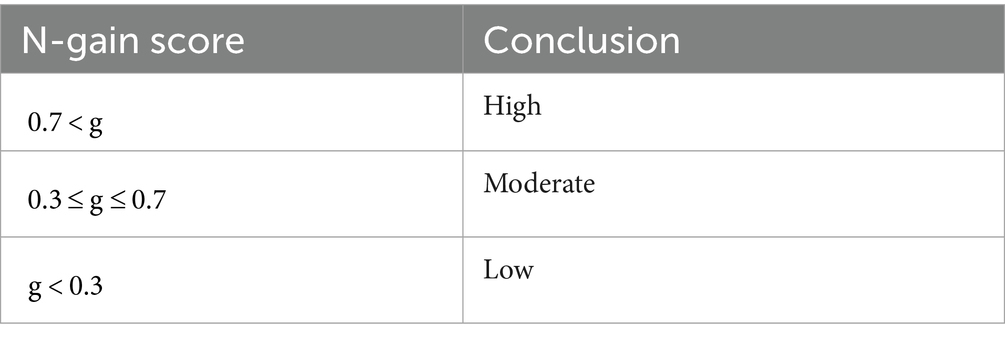
Table 5. N-gain score criteria based on Hake (1999).
4 Results and discussion
4.1 Results
4.1.1 The improvement of students’ mathematical communication skills
Data on students’ mathematical communication skills were collected through mathematical tests administered before (pretest) and after instruction (posttest) in both the experimental and control classes. The average scores for students’ mathematical communication abilities in the pretest and posttest for both the Islamic school and regular school are presented in Table 6.
Table 6 data indicate that the difference between pretest and posttest scores reveals an improvement in students’ mathematical communication skills in both the experimental and control classes at the Islamic school and regular school, though the increase level varies. The Islamic school experimental class observed the highest increase in mathematical communication skills, with a pretest and posttest score difference of 48.61.
To ensure that both the experimental and control groups had comparable initial abilities, an independent sample t-test was conducted on the pretest scores of students’ mathematical communication skills. The results showed no statistically significant difference between the experimental and control groups (p = 0.091). Therefore, the two groups have equivalent initial abilities, and any observed differences in N-Gain scores can be attributed to the treatment rather than to pre-existing differences. The N-gain scores for mathematical communication skills in the experimental and control classes are presented in Table 7.
Table 7 shows that all classes achieved N-Gain scores within the moderate criteria range. Notably, the highest N-gain score was observed in the experimental class at the Islamic school (N-Gain = 0.68), while the lowest N-Gain score was recorded in the control class at the regular school (N-Gain = 0.32). The experimental and control classes consisted of students with equivalent mathematical abilities. To ensure this, a normality test was conducted. The results of the normality and homogeneity tests are presented in Tables 8, 9.
Tables 8, 9 present the results of the normality and homogeneity tests for both the control and experimental groups in the Islamic school and the regular school. The significance (Sig) values for all groups are greater than 0.05, indicating that the data are normally distributed, homogeneous, and meet the assumptions for conducting parametric statistical tests. Subsequently, Table 10 presents data on the test results comparing the average N-Gain scores of students’ mathematical communication skills. The results indicate a difference in the average N-Gain scores for mathematical communication skills between Islamic and regular school students.
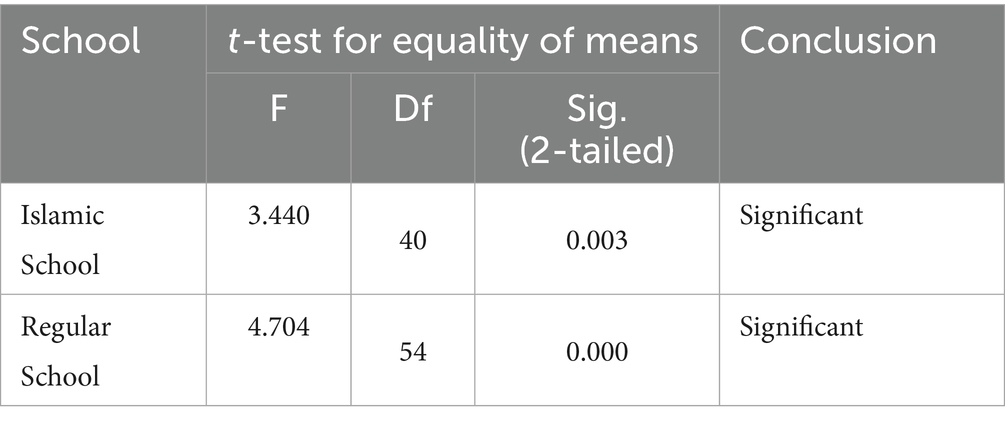
Table 10. T-test results on the N-gain scores of mathematical communication skills of Islamic and regular school students.
Table 10 shows a statistically significant difference between the N-Gain scores at the Islamic and regular school (α < 0.05). This indicates a difference in the improvement of mathematical communication skills between students taught using the interactive worksheet and those who did not use it in both school types.
4.1.2 Improvement in students’ knowledge of Islamic values
Data on students’ knowledge of Islamic values were gathered from a questionnaire administered before (pretest) and after (posttest) the learning sessions in the experimental and control classes. The average pretest and posttest scores are presented in Table 11.
Table 11 shows an increase in students’ knowledge of Islamic values in both the Islamic and regular schools following the learning sessions, though the extent of the increase differs. The largest improvement in mathematical communication skills was observed in the Islamic school experimental class, with a pretest-to-posttest score difference of 3.3. Furthermore, Table 12 presents the N-gain scores for students’ knowledge of Islamic values in experimental and control classes.
Table 12 shows that all classes achieved N-gain scores within the moderate criteria range. Notably, the highest N-Gain score was recorded in the experimental class at the Islamic school (N-Gain = 0.62), while the lowest was observed in the control class at the regular school (N-Gain = 0.37). The experimental and control classes consisted of students with equivalent mathematical abilities. To confirm this, a normality test was conducted and the results are presented in Tables 13, 14.
Tables 13, 14 present the results of the normality and homogeneity tests for both the control and experimental classes in Islamic and regular schools. The significance values (Sig) for all groups are greater than 0.05, indicating that the data are normally distributed, homogeneous, and meet the assumptions required for parametric statistical testing. Subsequently, Table 15 presents the test results comparing the average N-Gain scores of students’ knowledge of Islamic values. The results highlight differences in the average N-gain scores between students at Islamic and regular schools.
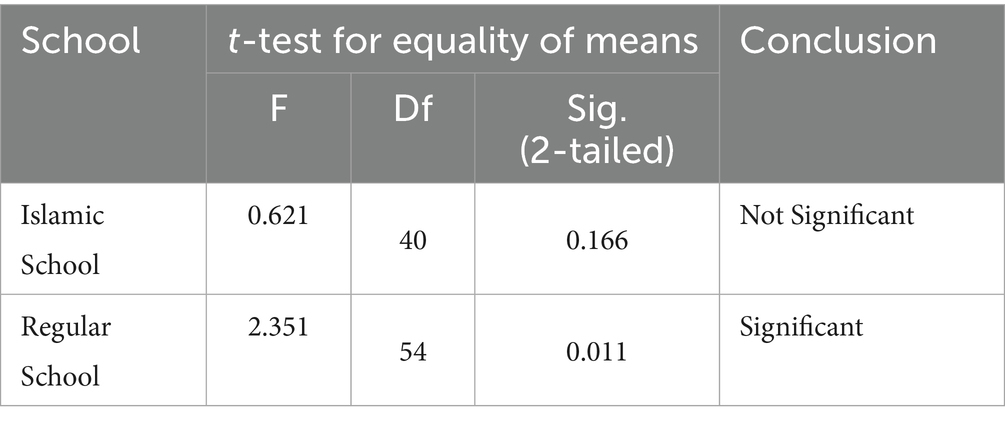
Table 15. T-test results of the N-gain students’ knowledge of Islamic values at Islamic and regular schools.
Table 15 shows no significant difference in the increase in students’ knowledge of Islamic values between those taught with the interactive worksheet and those taught without it in the Islamic school (α = 0.166). In contrast, the regular school’s significance value (α = 0.01) suggests a statistically significant difference. Therefore, the increase in students’ knowledge of Islamic values is greater for those taught using the interactive worksheet than those who learned without it in regular school.
4.1.3 The effect of school type and the use of interactive worksheets on the improvement of students’ mathematical communication skills and knowledge of Islamic values
The improvement of students’ mathematical communication skills and knowledge of Islamic values based on school type (Islamic school vs. regular school) and the use of interactive worksheets (control class vs. experimental class) is presented in Table 16.

Table 16. The effects of school type and the use of interactive worksheets on the improvement of students’ mathematical communication skills and knowledge of islamic values.
Table 16 shows that the school type (Islamic vs. regular) did not have a significant effect on the two dependent variables (Wilks’ Lambda = 0.956, p = 0.122, η2 = 0.044). This indicates that the type of school is not a primary determining factor in the improvement of students’ mathematical communication skills and knowledge Islamic values. In contrast, the class factor—specifically, the use of interactive worksheets (control vs. experimental)—had a significant effect on the improvement of both variables (Wilks’ Lambda = 0.819, p = 0.000, η2 = 0.181). This suggests that the use of interactive worksheets can enhance students’ mathematical communication skills and their understanding of Islamic values.
The MANOVA results revealed a large effect size (η2 = 0.181) for the use of interactive worksheets, indicating that this intervention had a practically significant impact on students’ mathematical communication skills and knowledge of Islamic values, beyond mere statistical significance. Although all groups showed N-gain improvements within the moderate category, the large η2 value suggests that the difference is educationally meaningful, particularly in the experimental class at the Islamic school, which recorded the highest N-gain of 0.68 in mathematical communication skills.
4.2 Discussion
Based on the research findings, there are five key findings that can be discussed. First, there is a significant difference in the improvement of mathematical communication skills between students taught using interactive worksheets and those taught without interactive worksheets in Islamic schools. Second, a similar significant difference is observed in regular schools, where students taught using interactive worksheets show greater improvement in mathematical communication skills compared to those who were not. In addition, the high N-gain scores in the experimental classes indicate that the use of contextual videos and GeoGebra in the interactive worksheets played a role in strengthening students’ understanding of both fraction concepts and Islamic values. In line with this, the integration of science and mathematics through a problem-based approach supported by technology such as GeoGebra can strengthen the learning of both disciplines while also fostering students’ confidence in STEM (Furner, 2024). Moreover, innovative technologies are utilized to transform science, mathematics, and STEM learning in primary and secondary schools, thereby enhancing student engagement, strengthening conceptual understanding, fostering collaboration and communication, and building teachers’ capacity in using technology for pedagogical purposes (Jong et al., 2024).
Bray and Tangney (2017) who found that digital technology offers innovative ways for students to build and comprehend mathematical knowledge. Furthermore, the effectiveness of electronic student worksheets in enhancing mathematical communication skills is supported by Wulandari and Andriyani (2022), whose study revealed a significant increase in students’ post-test scores. In addition, interactive media has been proven effective in exploring students’ mathematical communication abilities while also helping them achieve mastery learning (Ratnaningsih et al., 2024).
Third, there is no significant difference in the improvement of knowledge of Islamic values between students taught using interactive worksheets and those taught without interactive worksheets in Islamic schools. Islamic School students seem accustomed to learning about Islamic values from various sources through the Integrated Islamic School Network (JSIT) curriculum, which mandates the inclusion of Islamic values across all subjects (Muhab, 2014). Haryaningrum et al. (2017) explained that this curriculum includes structured learning activities, self-development, habits, and distinctive school programs, all delivered through a full-day school system. Thus, consistent and comprehensive exposure to Islamic values contributes to relatively stable student knowledge of Islamic values, regardless of the use of interactive worksheets.
Fourth, there is a significant difference in the improvement of knowledge of Islamic values between students taught using interactive worksheets and those taught without interactive worksheets in regular schools. This finding contrasts with the results from Islamic schools. It reinforces the idea that technological advancements in the era of Society 5.0 enable the integration of Islamic values into mathematics instruction to be implemented more easily, thereby facilitating the formation of students’ spiritual and moral character (Triana et al., 2023). The seamless integration of science and Islamic education through mobile media is designed to enhance student learning while fostering an active learning environment that supports the growth of spiritual-religious potential, self-regulation, personal integrity, intelligence, moral character, and key competencies essential to students, society, the nation, and the state. This integration has also been proven effective in cultivating religious character in education (Fahyuni et al., 2020).
Fifth, there is no significant effect of school type on the improvement of students’ mathematical communication skills and knowledge of Islamic values. This indicates that both religious-based and regular schools have equal potential to develop students’ abilities, provided that appropriate instructional interventions are applied. Religious education should equip students with the knowledge and skills needed to fully engage in discussions and decision-making on issues involving religion (Soules and del Nido, 2025). In this context, while school background does not appear to have a significant influence, the use of interactive worksheets does affect the improvement of students’ mathematical communication skills and knowledge of Islamic values. This suggests that the quality of instructional tools is a more decisive factor in learning outcomes than the type of school. Consistent with this finding, mathematics learning tools integrated with Qur’anic values have been shown to enhance students’ spiritual awareness and mathematical attitudes (Winarso and Wahid, 2020).
A potential source of bias lies in the use of computer-based interactive worksheets, which may generate higher levels of enthusiasm among both students and teachers. Technology-based learning methods have been shown to exert a stronger influence on student engagement compared to conventional methods (Fannakhosrow et al., 2022). In addition, teachers who use interactive media often demonstrate greater enthusiasm in delivering lessons, which in turn affects student motivation. The positive impact of teacher enthusiasm on the quality of instruction has been well-documented (Cui et al., 2017; Kunter et al., 2008, 2011, 2013; Lazarides et al., 2018).
5 Conclusion
This study concludes that the implementation of interactive worksheets in mathematics learning has a meaningful impact on student learning outcomes, both cognitively and affectively. Several key findings support this conclusion. First, there is a significant difference in the improvement of mathematical communication skills between students taught using interactive worksheets and those taught without interactive worksheets in Islamic schools. Second, a similar significant difference is observed in regular schools. Third, there is no significant difference in the improvement of knowledge of Islamic values between students taught using interactive worksheets and those taught without interactive worksheets in Islamic schools. Fourth, there is a significant difference in the improvement of knowledge of Islamic values between students taught using interactive worksheets and those taught without interactive worksheets in regular schools. Fifth, school type does not have a significant effect on the improvement of students’ mathematical communication skills or knowledge of Islamic values. However, the use of interactive worksheets has a significant effect on the improvement of students’ mathematical communication skills and knowledge of Islamic values.
This study demonstrates the potential of integrating Islamic values into mathematics learning through interactive worksheets contextualized in qurban practices. Students showed significant improvements in both mathematical communication skills and knowledge of Islamic values, particularly when learning was situated in meaningful and culturally relevant scenarios. Overall, these findings suggest that interactive worksheets hold promise as a medium for integrating mathematical communication skills with Islamic values in the teaching of fractions. Nevertheless, these results should be regarded as preliminary given the methodological and contextual limitations. The study contributes primarily as an exploratory effort to design culturally responsive STEM learning resources in the context of Aceh. Further research with stronger instruments, longer interventions, and larger, more diverse samples is needed to confirm and extend these findings.
6 Limitations
This study has several limitations that should be considered when interpreting the results and generalizing the findings. The reliability of the mathematical communication skills test was still low (α = 0.488), so the results did not fully reflect students’ abilities. The dichotomous questionnaire used only measured factual knowledge of Islamic values and did not capture ethical reasoning, moral practice, or spiritual reflection. The intervention was limited to three sessions and involved only two schools with 98 students, making it difficult to generalize the findings. In addition, the observed improvement may have been influenced by the novelty effect of using digital tools and teachers’ enthusiasm. Future studies should employ more reliable instruments, more diverse assessment formats, longer interventions, and larger samples.
Data availability statement
The original contributions presented in the study are included in the article/supplementary material, further inquiries can be directed to the corresponding author.
Ethics statement
The studies involving humans were approved by Department of Education and Culture of Banda Aceh, Indonesia. The studies were conducted in accordance with the local legislation and institutional requirements. Written informed consent for participation in this study was provided by the participants’ legal guardians/next of kin.
Author contributions
RJ: Supervision, Writing – original draft, Writing – review & editing. MI: Methodology, Writing – review & editing. ZI: Validation, Writing – review & editing. CK: Writing – review & editing. EE: Validation, Writing – review & editing. UR: Writing – review & editing, Writing – original draft. MG: Writing – review & editing.
Funding
The author(s) declare that financial support was received for the research and/or publication of this article. The authors extend their sincere gratitude to the Research Center of Realistic Mathematics Education team at Universitas Syiah Kuala for their research collaboration, and to Universitas Syiah Kuala for providing financial support for this research (Grant number: 22/UN11.2.1/PT.01.03/PNBP/2023). We also express our appreciation to all participants involved in this study.
Conflict of interest
The authors declare that the research was conducted in the absence of any commercial or financial relationships that could be construed as a potential conflict of interest.
Generative AI statement
The authors declare that no Gen AI was used in the creation of this manuscript.
Any alternative text (alt text) provided alongside figures in this article has been generated by Frontiers with the support of artificial intelligence and reasonable efforts have been made to ensure accuracy, including review by the authors wherever possible. If you identify any issues, please contact us.
Publisher’s note
All claims expressed in this article are solely those of the authors and do not necessarily represent those of their affiliated organizations, or those of the publisher, the editors and the reviewers. Any product that may be evaluated in this article, or claim that may be made by its manufacturer, is not guaranteed or endorsed by the publisher.
Footnotes
References
Abdussakir, A., and Rosimanidar, R. (2017). Model integrasi matematika dan Al-Quran serta praktik pembelajarannya. Seminar Nasional Integrasi Matematika di dalam Al-Quran oleh HMJ Pendidikan Matematika IAIN Bukittinggi, Sumbar, 26 April 2017.
Ansari, B. I. (2019). Komunikasi matematika: Strategi berpikir dan manajemen belajar, konsep dan aplikasi. Banda Aceh, Indonesia: Yayasan Pena
Astuti, A., and Leonard, L. (2015). Peran kemampuan komunikasi matematika terhadap prestasi belajar matematika siswa. Formatif: Jurnal Ilmiah Pendidikan MIPA 2, 102–110. doi: 10.30998/formatif.v2i2.91
Bailey, D. H., Hoard, M. K., Nugent, L., and Geary, D. C. (2012). Competence with fractions predicts gains in mathematics achievement. J. Exp. Child Psychol. 113, 447–455. doi: 10.1016/j.jecp.2012.06.004
Baroody, A. J. (2000). Does mathematics instruction for three-to five-year-olds really make sense? Young Child. 55, 61–67.
Bergeson, T. (2000). Teaching and learning mathematics: Using research to shift from the “yesterday” mind to the “tomorrow” mind. Washington, DC: State Superintendent of Public Instruction.
Bray, A., and Tangney, B. (2017). Technology usage in mathematics education research–a systematic review of recent trends. Comput. Educ. 114, 255–273. doi: 10.1016/j.compedu.2017.07.004
Bybee, R. W. (2013). The case for STEM education challenges and opportunities. Washington, DC: National STEM Teachers Asociation.
Creswell, J. W. (2014). Research design: Qualitative, quantitative, and mixed methods approach. Thousand Oaks, CA: SAGE Publications.
Cui, G., Yao, M., and Zhang, X. (2017). The dampening effects of perceived teacher enthusiasm on class-related boredom: the mediating role of perceived autonomy support and task value. Front. Psychol. 8:400. doi: 10.3389/fpsyg.2017.00400
Dewi, A. K., Slamet, S. Y., Atmojo, I. R. W., and Syawaludin, A. (2022). The influence of interactive digital worksheets based on level of inquiry towards science process skills. Pegem J. Educ. Instr. 13, 251–258. doi: 10.47750/pegegog.13.01.27
Fahyuni, E. F., Wasis Bandono, A., and Arifin, M. B. U. B. (2020). Integrating Islamic values and science for millennial students’ learning on using seamless mobile media. J. Pendidik. IPA Indones. 9, 231–240. doi: 10.15294/jpii.v9i2.23209
Fannakhosrow, M., Nourabadi, S., Tran Ngoc Huy, D., Dinh Trung, N., and Tashtoush, M. A. (2022). A comparative study of information and communication technology (ICT)-based and conventional methods of instruction on learners’ academic enthusiasm for L2 learning. Educ. Res. Int. 8:5478088. doi: 10.1155/2022/5478088
Ferdinan, M., and Pewangi, M. (2025). Integration of Islamic values in the field of general studies at SMP Unismuh Makassar: evaluation of the stake countenance model approach. Educ. Process. Int. J. 14:e2025059. doi: 10.22521/edupij.2025.14.59
Furner, J. M. (2024). Creating connections: using problem-based instruction with mathematics and technology like GeoGebra for STEM integration. Int. J. Educ. Math. Sci. Technol. 12, 957–970. doi: 10.46328/ijemst.4018
Guiler, W. S. (1945). Difficulties in fractions encountered by ninth-grade pupils. Elem. Sch. J. 46, 146–156. doi: 10.1086/458802
Hake, R. R. (1997). Interactive engagement versus traditional methods: a six-thousand-student survey of mechanics test data for introductory physics courses. Am. J. Phys. 66, 64–74.
Halistin, H., Patih, T., Amalia, H. A. M., Ahmad, A., Zur, S., Samrin, S., et al. (2022). Interconnectedness of math, biology and Islamic education: designing teaching materials for high school in international conference: transdisciplinary paradigm on Islamic knowledge. KnE Soc. Sci 22, 217–228. doi: 10.18502/kss.v7i8.10739
Haryaningrum, R., Muhdi, M., and Retnaningdyastuti, S. (2017). Manajemen Kurikulum Sekolah Dasar Islam Terpadu Insan Mulia Kajen Kabupaten Pekalongan. J. Manaj. Pendidik. 6, 129–141. doi: 10.26877/jmp.v6i2.1994
Høyrup, J. (1987). The formation of “Islamic mathematics” sources and conditions. Sci. Context. 1, 281–329. doi: 10.1017/S0269889700000399
Ibrahim, M., Islam, S., Zohriah, O., and Azid, M. (2024). Addressing contemporary ethical and moral issues through Islamic education. J. Islamic Stu. 1, 36–51. doi: 10.35335/kbbzar83
Irawan, A., and Kencanawaty, G. (2017). Implementasi pembelajaran matematika realistik berbasis etnomatematika. J. Medives 1, 74–81.
Isik, C., and Kar, T. (2012). Analyzing problems posed by 7th grade students for addition operation with fractions. Elem. Educ. Online 11, 1021–1035.
Ismail, F. (2018). Pelaksanaan Kurikulum JSIT (Jaringan Sekolah Islam Terpadu) di Sekolah Dasar Islam Terpadu Al Furqoon Palembang. Muaddib 8, 14–33. doi: 10.24269/muaddib.v8i1.1049
Jong, M. S.-Y., Zhai, X., and Chen, W. (2024). Innovative uses of technologies in science, mathematics and STEM education in K-12 contexts. Int. J. Sci. Math. Educ. 22, 1–S9. doi: 10.1007/s10763-024-10530-x
Kunter, M., Frenzel, A., Nagy, G., Baumert, J., and Pekrun, R. (2011). Teacher enthusiasm: dimensionality and context specificity. Contemp. Educ. Psychol. 36, 289–301. doi: 10.1016/j.cedpsych.2011.07.001
Kunter, M., Klusmann, U., Baumert, J., Richter, D., Voss, T., and Hachfeld, A. (2013). Professional competence of teachers: effects on instructional quality and student development. J. Educ. Psychol. 105, 805–820. doi: 10.1037/a0032583
Kunter, M., Tsai, Y. M., Klusmann, U., Brunner, M., Krauss, S., and Baumert, J. (2008). Students' and mathematics teachers' perceptions of teacher enthusiasm and instruction. Learn. Instr. 18, 468–482. doi: 10.1016/j.learninstruc.2008.06.008
Lazarides, R., Buchholz, J., and Rubach, C. (2018). Teacher enthusiasm and self-efficacy, student-perceived mastery goal orientation, and student motivation in mathematics classrooms. Teach. Teach. Educ. 69, 1–10. doi: 10.1016/j.tate.2017.08.017
Lee, J. (2015). “Oh, I just had it in my head”: Promoting mathematical communications in early childhood. Contemp. Issues Early Child. 16, 284–287. doi: 10.1177/1463949115600054
Lindenbauer, E. (2020). A digital worksheet for diagnosing and enhancing students’ conceptions in functional thinking. Math. Educ. Digit. Age. :247.
Manouchehri, A., and St John, D. (2006). From classroom discussions to group discourse. Math. Teach. 99, 544–552. doi: 10.5951/MT.99.8.0544
Muslimin, M., Putri, R. I. I., Zulkardi, Z., and Aisyah, N. (2020). Learning Integers with Realistic Mathematics Education Approach based on Islamic Values. J. Math. Educ. 11, 363–384. doi: 10.22342/jme.11.3.11721.363-384
Newstead, K., and Murray, H. (1998). “Young students’ constructions of fractions” in Proceedings of the 22nd conference of the International Group for the Psychology of mathematics education. 3. Stellenbosch, South Africa. eds. A. Olivier and K. Newstead (New York, NY: ERIC), 295–303.
Ni, Y., and Zhou, Y. (2005). Teaching and learning fraction and rational numbers: the origins and implications of whole number bias. Educ. Psychol. 40, 27–52. doi: 10.1207/s15326985ep4001_3
Pourdavood, B. R. G., and Wachira, P. (2015). Importance of mathematical communication and discourse in secondary classrooms. Glob. J. Sci. Front. Res.: F Math. Decis. Sci. 15, 1–13.
Rahman, B., Abdurrahman, A., Kadaryanto, B., and Rusminto, N. E. (2015). Teacher-based scaffolding as a teacher professional development program in Indonesia. Aust. J. Teach. Educ. 40, 66–78. doi: 10.14221/ajte.2015v40n11.4
Ratnaningsih, N., Said Husain, S. K., Patmawati, H., Sukirwan, S., Hidayat, E., and Romdiani, N. S. (2024). Articulate storyline 3 based interactive media to explore mathematical communication ability: development and implementation. J. Eng. Sci. Technol. 19, 1811–1830.
Rohid, N. (2019). Students’ mathematical communication skills (mcs) in solving mathematics problems: a case in Indonesian context. Anatol. J. Educ. 4, 19–30. doi: 10.29333/aje.2019.423a
Rosila, N., and Yaakob, N. (2007). Penguasaan Jawi dan hubungannya dengan minat dan pencapaian pelajar dalam Pendidikan Islam. J. Pendidik. Pendidik. 22, 161–172.
Rubenstein, R. N., and Thompson, D. R. (2002). Understanding and supporting children's mathematical vocabulary development. Teach. Child. Math. 9, 107–112. doi: 10.5951/TCM.9.2.0107
Salafudin, S. (2015). Pembelajaran matematika yang bermuatan nilai Islam. Jurnal Penelitian 12, 223–243. doi: 10.28918/jupe.v12i2.651
Salleh, J. M., Kedin, N. A., Sulaiman, S. B., and Mahat, M. A. (2023). The muslim community’s understanding of the basic laws of Qurban distribution. Int. J. Acad. Res. Bus. Soc. Sci. 13, 1464–1473. doi: 10.6007/IJARBSS/v13-i1/15132
Salsabila, N., Johar, R., Ikhsan, M., Idami, Z., Khairunnisak, C., Ellianti,, et al. (2024). Validity of e-modules for teaching fractions through realistic mathematics education with the context of sacrifice worship (ibadah Kurban). Al Khawarizmi 8, 69–80. doi: 10.22373/jppm.v8i1.22850
Shalonda, H. S. (2024). The effect of using models to enhance grade 7 learners’ understanding of fractions: a case of a primary school in Onankali circuit, Oshikoto region (master's thesis, University of Namibia). Namibia: University of Namibia.
Siegler, R. S., and Lortie-Forgues, H. (2014). An integrative theory of numerical development. Child Dev. Perspect. 8, 144–150. doi: 10.1111/cdep.12077
Smieskova, E. (2017). Communication students' skills as a tool of development creativity and motivation in geometry. Universal J. Educ. Res. 5, 31–35. doi: 10.13189/ujer.2017.050104
Soules, K. E., and del Nido, D. (2025). Mapping the field of K–12 religious literacy education: a working report. Relig. Educ. 52, 32–57. doi: 10.1080/15507394.2025.2468570
Stafylidou, S., and Vosniadou, S. (2004). The development of students’ understanding of the numerical value of fractions. Learn. Instr. 14, 503–518. doi: 10.1016/j.learninstruc.2004.06.015
Sujarwanto, E., Madlazim,, and Ibrahim, M. (2019). Attitude, knowledge, and application of STEM owned by science teachers. J. Phys. Conf. Ser. 1417:012096. doi: 10.1088/1742-6596/1417/1/012096
Sumarmi, S., Aliman, M., and Mutia, T. (2021). The effect of digital eco-learning in student worksheet flipbook to environmental project literacy and pedagogic competency. Journal of Technology and Science Education. 11, 357–370. doi: 10.3926/jotse.1175
Susanto, D., Kurniawan, T., Sihombing, S. K., Salim, E., Radjawane, M. M., Salmah, U., et al. (2021). Buku panduan guru matematika SMA/SMK kelas X. Jakarta: Pusat Kurikulum dan Perbukuan Kemendikbudristek.
Tene, T., Marcatoma Tixi, J. A., Palacios Robalino, M.d. L., Mendoza Salazar, M. J., Vacacela Gomez, C., and Bellucci, S. (2024). Integrating immersive technologies with STEM education: a systematic review. Front. Educ. 9:1410163, 1–20. doi: 10.3389/feduc.2024.1410163
Treffers, A. (1987). Realistic mathematics education in the Netherlands. Utrecht: Freudenthal University, Utrecht CD Press.
Triana, A. Y., Supono, A., and Aini, A. N. (2023). “Integrating Islamic values on math learning in welcoming the society 5.0: how it works?” in Proceedings of the 3rd annual conference on Islamic education (ACIE 2022), advances in social science, education and humanities research. ed. D. P. Adi (London: Atlantis Press), 203–211.
Ulpah, M., and Novikasari, I. (2020). Developing Islamic context-based learning materials in increasing students’ mathematical understanding. Al-Jabar: J. Pendidik. Mat. 11, 29–38. doi: 10.24042/ajpm.v11i1.5432
Unlu, M., and Ertekin, E. (2012). Why do pre-service teachers pose multiplication problems instead of division problems in fractions? PRO 46, 490–494. doi: 10.1016/j.sbspro.2012.05.148
Utaminingsih, S., Amalia, I., and Sumanji, S. (2024). Management of mathematics learning based on interactive digital worksheets to improve students' critical thinking ability. J. Curric. Teach. 13, 159–169. doi: 10.5430/jct.v13n1p159
van den Heuvel-Panhuizen, M. (2005). The role of context in assessment problems in mathematics. For Learn. Math. 25, 2–23.
van den Heuvel-Panhuizen, M., and Drijvers, P. (2020). Realistic mathematics education. Encycl. Math. Educ 22, 713–717. doi: 10.1007/978-3-030-15789-0
Walidin, W. (2005). Refleksi pendidikan Aceh dulu kini dan ke depan. Diseminarkan dalam panel “Recovery Pendidikan NAD”. Malang: Forum Mahasiswa Aceh.
Wang, J., Tigelaar, D., Zhou, T., and Admiraal, W. (2022). The effects of mobile technology usage on cognitive, affective, and behavioural learning outcomes in primary and secondary education: A systematic review with meta‐analysis. J. Comput. Assist. Learn. 39, 301–328. doi: 10.1111/jcal.12759
Whitin, P., and Whitin, D. J. (2003). Developing mathematical understanding along the yellow brick road. Young Child. 58, 36–40.
Wibawa, S. C., Cholifah, R., Utami, A. W., and Nurhidayat, A. I. (2018). Creative digital worksheet base on mobile learning. IOP Conference Series Mat. Sci. Eng. 288:012130. doi: 10.1088/1757-899X/288/1/012130
Winarso, W., and Wahid, S. (2020). Development of mathematics teaching device integrated with Quranic values: issues, challenges, and implementation model. Int. J. Learn. Teach. Educ. Res. 19, 95–117. doi: 10.26803/ijlter.19.1.6
Wulandari, F., and Andriyani, D. (2022). Development of problem-based e-worksheet to enhance mathematics’ communication skill in cartesian coordinates. J. Pendidik. MIPA 23, 569–584. doi: 10.23960/jpmipa/v23i2.pp569-584
Keywords: mathematical communication skills, Islamic values, interactive worksheets, fractions, seventh-grade students
Citation: Johar R, Ikhsan M, Idami Z, Khairunnisak C, Ellianti E, Rohaizati U and Ghazali M (2025) Enhancing mathematical communication and Islamic values in Islamic and regular schools through interactive worksheets. Front. Educ. 10:1633056. doi: 10.3389/feduc.2025.1633056
Edited by:
Khajornsak Buaraphan, Mahidol University, ThailandReviewed by:
Muh Barid Nizarudin Wajdi, STAI Miftahul Ula, IndonesiaWararat Wongkia, Mahidol University Institute for Innovative Learning, Thailand
Copyright © 2025 Johar, Ikhsan, Idami, Khairunnisak, Ellianti, Rohaizati and Ghazali. This is an open-access article distributed under the terms of the Creative Commons Attribution License (CC BY). The use, distribution or reproduction in other forums is permitted, provided the original author(s) and the copyright owner(s) are credited and that the original publication in this journal is cited, in accordance with accepted academic practice. No use, distribution or reproduction is permitted which does not comply with these terms.
*Correspondence: Rahmah Johar, cmFobWFoLmpvaGFyQHVzay5hYy5pZA==
 Rahmah Johar
Rahmah Johar M. Ikhsan
M. Ikhsan Zahratul Idami
Zahratul Idami Cut Khairunnisak
Cut Khairunnisak Ellianti Ellianti
Ellianti Ellianti Ulya Rohaizati
Ulya Rohaizati Munirah Ghazali
Munirah Ghazali
